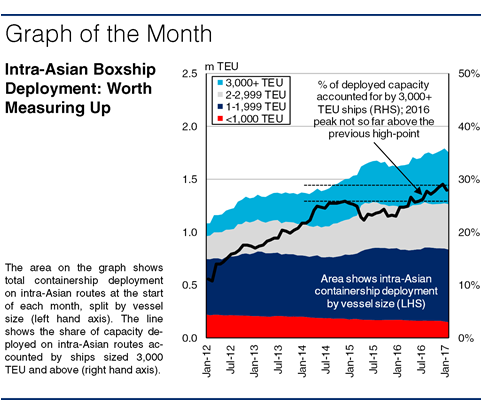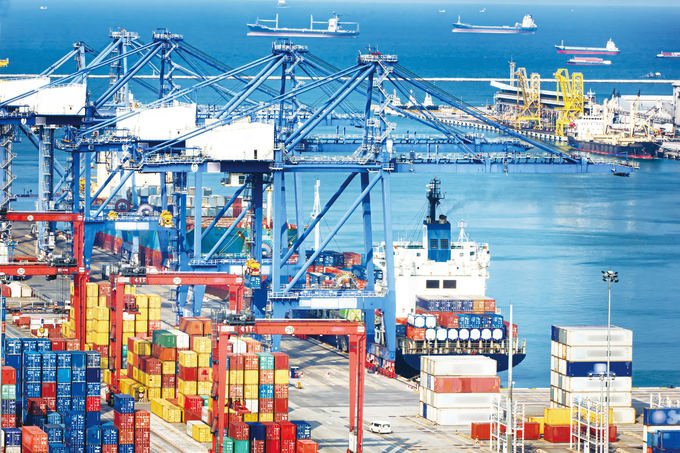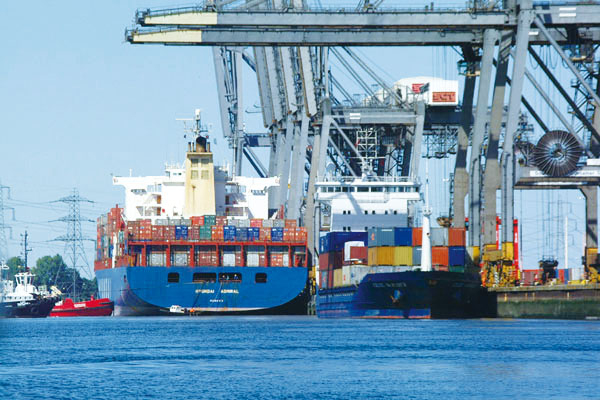
Container trade on intra-Asian routes accounts for a significant proportion of global seaborne container trade, and in 2016, growth in intra-Asian box trade accelerated notably, helping to generate a healthier demand environment in the boxship sector. Meanwhile, trends in containership deployment on intra-Asian routes continued to constitute a key dynamic on the supply side.
Intra-Asian container trade totalled an estimated 52m TEU in 2016, accounting for around 29% of global box volumes. More than half of intra-Asian box trade involves China, with trends in the Chinese economy key drivers of intra-Asian volume growth. In 2015, turbulence in the Chinese economy contributed to a slowing of intra-Asian box trade growth to 3.0%, but seemingly reduced uncertainty surrounding in China allied to robust growth elsewhere in developing Asia in 2016 boosted expansion in intra-Asian container trade to an estimated 5.6%.
Meanwhile, boxship capacity deployed on intra-Asian routes has continued to increase, and stood at c.1.8m TEU in nominal terms at the start of 2017. Intra-Asian deployment trends have a major influence on the wider containership market, with upsizing on intra-Asian routes having in the past limited demand in the charter market for smaller ships. The share of deployed capacity on intra-Asian routes accounted for by ships of 3,000+ TEU rose from 10% in early 2012, to around 25% in mid-2014, before falling to 23% by the start of 2016 as opportunities to ‘cascade’ further larger ships onto the intra-Asian arena became more limited.

2016 saw further interesting deployment dynamics. The volume of capacity deployed on intra-Asian routes on ships sub-3,000 TEU remained steady in 2016, and deployment of ships 3,000+ TEU rose to 29% of total intra-Asian deployment (0.5m TEU). However, in the context of recent history and the robust rate of trade growth, this appears at this stage to have been a quite limited increase, up marginally from the previous peak of 26% at the start of 2015, and perhaps less dramatic than might have been expected.
More than half of the total increase in the deployment of 3,000+ TEU ships during last year was accounted for by greater deployment on relatively longer-haul routes connecting East Asia (including China, Japan and Korea) with South East Asia. This is where one might expect the additional deployment of larger ships. However, the number of 3,000+ TEU ships deployed on coastal Chinese routes has also increased, rising by around 10 ships to 44 vessels; it was not the main element of the increase, but it is probably worth watching closely in terms of future upsizing opportunities.
So, although 2016 saw additional deployment of larger boxships on intra-Asian routes, the trend in increased deployment was not sharp; further opportunities may be becoming more limited. However, there are clearly still some parts of the intra-Asian trade network that need to be watched closely. As always, getting the measure of the wider boxship market depends heavily on trends in Asia.
(Source : Clarksons)

















